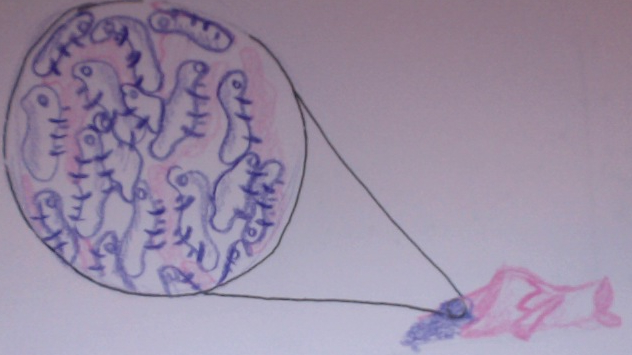What is the reason for this huge population increase? We have a theory.
What probably caused the initial decrease was the Pinks' natural predator, the purple algae. Most of the organisms on Heart are microbial, including predators. Purple algae is a microorganism that is harmful only to Pinks. Most, if not all, of Heart’s water supply contains purple algae. This is a special kind of organism that erodes the flesh of Pinks for nutrients. It also has the side effect of killing the Pink host. Reds have immunity to purple algae, and thus are not affected. However, the Pink community was ravaged almost five hundred years ago when there was a sudden spike in the purple algae population. To protect the Pinks, the Reds created reservations under the surface of the planet. These reservations were provided with a steady nutrient supply that allowed the Pinks to be free from the purple algae.

Purple Algae, pictured here magnified by 10,000x, consuming the membrane of a Pink
The Reds have been heavily criticized for this, and it raises some interesting moral questions: If a species is dying out, who are we to say if it isn’t just the proper course of nature? Then again, who is to say it isn’t? It is true that if the Reds had not saved the Pinks all those years ago, they would not be in their current ecological crises. But enough on focusing on what they did—the goal now is to look on how to fix it.
What caused the dramatic population increase was that because purple algae was the Pinks’ only real predator, it was the only thing keeping the population in check. Now, the population is growing without limit, and eventually resources will be completely depleted from the planet. What we need to do now is figure out a solution. The HCA has made a number of solutions, but they all involve a significant amount of sacrifice, from both the people of Heart, and from you!
What probably caused the initial decrease was the Pinks' natural predator, the purple algae. Most of the organisms on Heart are microbial, including predators. Purple algae is a microorganism that is harmful only to Pinks. Most, if not all, of Heart’s water supply contains purple algae. This is a special kind of organism that erodes the flesh of Pinks for nutrients. It also has the side effect of killing the Pink host. Reds have immunity to purple algae, and thus are not affected. However, the Pink community was ravaged almost five hundred years ago when there was a sudden spike in the purple algae population. To protect the Pinks, the Reds created reservations under the surface of the planet. These reservations were provided with a steady nutrient supply that allowed the Pinks to be free from the purple algae.

Purple Algae, pictured here magnified by 10,000x, consuming the membrane of a Pink
The Reds have been heavily criticized for this, and it raises some interesting moral questions: If a species is dying out, who are we to say if it isn’t just the proper course of nature? Then again, who is to say it isn’t? It is true that if the Reds had not saved the Pinks all those years ago, they would not be in their current ecological crises. But enough on focusing on what they did—the goal now is to look on how to fix it.
What caused the dramatic population increase was that because purple algae was the Pinks’ only real predator, it was the only thing keeping the population in check. Now, the population is growing without limit, and eventually resources will be completely depleted from the planet. What we need to do now is figure out a solution. The HCA has made a number of solutions, but they all involve a significant amount of sacrifice, from both the people of Heart, and from you!
About Heart
About The HCA
The People of Heart
The Pink Population Problem
The Theory
Proposed Solutions
What You Can Do